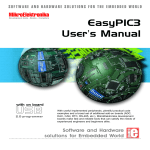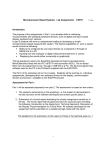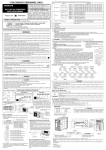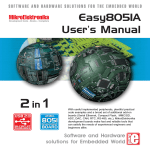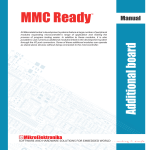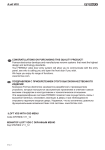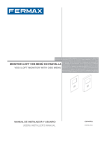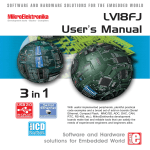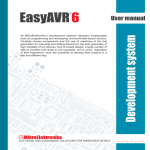Download PICPLC16 Manual - MikroElektronika
Transcript
SOFTWARE AND HARDWARE SOLUTIONS FOR THE EMBEDDED WORLD MikroElektronika Development tools - Books - Compilers PICPLC 16 User’s Manual with on board USB 2.0 programmer PICPLC16 is a system designed for controlling industrial systems and machines. 16 inputs with optocouplers and 16 relays (up to 10A) can satisfy many industrial needs. PICPLC16 can serve as remote control system by means of RS-485 communication. Software and Hardware solutions for Embedded World MikroElektronika Development tools PICPLC 16 User’s Manual First edition November 2005 No part of this manual, including the product and software described in it, may be reproduced, transmitted, transcribed, stored in a retrieval system, or translated into any language in any form or by any means, except documentation kept buy the purchaser for backup purposes, without the express written permission of MikroElektronika company. Product warranty or service will not be extended if the product is repaired, modified or altered, unless such repair, modification or alteration is authorized in writing by MikroElektronika. MIKROELEKTRONIKA PROVIDE THIS MANUAL “AS IS” WITHOUT WARRANTY OF ANY KIND, EITHER EXPRESS OR IMPLIED, INCLUDING BUT NOT LIMITED TO THE IMPLIED WARRANTIES OR CONDITIONS OF MERCHANTABILITY OR FITNESS FOR A PARTICULAR PUROSE. IN NO EVENT SHALL MIKROELEKTRONIKA, ITS DIRECTORS, OFFICERS, EMPLOYEES OR DISTRIBUTORS BE LIABLE FOR ANY INDIRECT , SPECIAL, INCIDENTAL, OR CONSEQUENTIAL DAMAGES(INCLUDING DAMAGES FOR LOSS OF PROFITS, LOSS OF BUSINESS, LOSS OF USE OR DATA, INTERRUPTION OF BUSINESS AND THE LIKE) EVEN IF MIKROELEKTRONIKA HAS BEEN ADVISED OF THE POSSIBILITY OF SUCH DAMAGES ARISING FROM ANY DEFECT OR ERROR IN THIS MANUAL OR PRODUCT. SPECIFICATION AND INFORMATION CONTAINED IN THIS MANUAL ARE FURNISHED FOR INTERNATIONAL USE ONLY, AND ARE SUBJECT TO CHANGE AT ANY TIME WITHOUT NOTICE , AND SHOULD BE CONSTRUED AS A COMMITMENT BY MIKROELEKTRONIKA MikroElektronika assumes no responsibility or liability for any errors or inaccuracies that may appear in this manual, including the product and software described in it. Product and corporate names appearing in this manual may or may not be registered trademarks or copyrights of their respective companies, and are used only for identification or explanation and to the owners benefit, without intent to infringe. USB PICPLC 16 MIKROELEKTRONIKA SOFTWARE AND HARDWARE SOLUTIONS FOR THE EMBEDDED WORLD page 2 MikroElektronika Development tools CONTENTS USB PICPLC 16 CONNECTING THE SYSTEM page 4 INTRODUCTION page 5 DESCRIPTION OF THE DEVELOPMENT SYSTEM page 6 Jumpers page 6 MCU socket page 7 Power Supply page 9 Power Supply Supervisor & Reset circuit page 11 On-board USB programmer page 12 RS-232 Communication page 14 RS-485 Communication page 16 PS/2 (Keyboard) connector page 18 Optocouplers page 19 Releys page 21 Direct port access page 23 MIKROELEKTRONIKA SOFTWARE AND HARDWARE SOLUTIONS FOR THE EMBEDDED WORLD page 3 CONTENTS PICPLC 16 User’s Manual CONNECTING THE SYSTEM PICPLC 16 User’s Manual MikroElektronika Development tools CONNECTING THE SYSTEM The development system box contains a development system, CD, USB cable and serial cable. Step no.1 The first thing to do is to take the system out of a box. Unpack the USB cable and connect it to the PC. Please use USB ports from the back of the PC, with direct contact to the motherboard. Step no.2 Connect MCU power supply to the PICPLC16 board. Step no.3 Connect the USB cable to the PICPLC16 board. Step no.4 The PC will start the procedure for installing the USB driver for the on-board USB 2.0 programmer. Follow the procedure from the document ‘ Installing Driver for USB programmer’ and install the USB driver. Step no.5 Copy PICFLASH2.exe file to the folder of your choice. You can find this file in the PICFLASH folder on the CD. Step no.6 Run and use PICFLASH2 as explained in the document ‘PICflash programmer’. After these 6 steps, your PICPLC16 is installed and ready for use. You should try to read a program from the chip or to load an example from the examples folder. page 4 MIKROELEKTRONIKA SOFTWARE AND HARDWARE SOLUTIONS FOR THE EMBEDDED WORLD USB PICPLC 16 MikroElektronika Development tools PICPLC 16 User’s Manual The PICPLC16 development system is a industrial development board for Microchip PIC microcontrollers. It allows PIC microcontrollers to be interfaced with external circuits and a broad range of peripheral devices, allowing the user to concentrate on software development. Figure 1 illustrates the development board. On a silkscreen, there are identification marks beside each component. These marks describe connections to the microcontroller, operation modes, and provide some useful notes. The need for additional schematics is minimized as all the information is printed on the board. Figure 1. PICPLC16 development board USB PICPLC 16 MIKROELEKTRONIKA SOFTWARE AND HARDWARE SOLUTIONS FOR THE EMBEDDED WORLD page 5 INTRODUCTION INTRODUCTION PICPLC 16 User’s Manual MikroElektronika Development tools JUMPERS JUMPERS Jumpers can break or establish a connection between two points. Beneath the plastic cover of the jumper is a metal contact, which makes a connection when the jumper is placed between two disconnected pins. For example J14 is used to connect or disconnect Tx line for RS-232 Communication. Connection is made when the jumper is placed between two contacts. Figure 2. Jumper is ON Jumper as a switch Jumper is OFF More often, jumpers are used as a selector between two possible connections using a three pin connector. As illustrated in Fig. 3, middle connector can be connected to the left or right pin, depending on the jumper’s position. . Figure 3. All lines are disconneced Jumper as a multiplexer Left line is selected Right line is selected page 6 MIKROELEKTRONIKA SOFTWARE AND HARDWARE SOLUTIONS FOR THE EMBEDDED WORLD USB PICPLC 16 MikroElektronika Development tools MCU SOCKET The PICPLC16 development board support a 40-pin microcontrollers in DIP40 package as shown on the following picture: Figure 4. USB PICPLC 16 MCU socket MIKROELEKTRONIKA SOFTWARE AND HARDWARE SOLUTIONS FOR THE EMBEDDED WORLD page 7 MCU SOCKET PICPLC 16 User’s Manual MikroElektronika Development tools PICPLC 16 User’s Manual MCU CARD The microcontroller’s pins are routed to various peripherials as illustrated in Figure 5. All ports have direct connections to Direct Port Access connectors. Such connectors are typically used for connecting external peripherials to the board, or for providing useful points for connecting digital logic probes. Some of the pins are connected to other peripherials such as optocouplers, RS-232 communication, RS-485 communication, etc. Figure 5. System connection Input optocouplers Port connector vcc Pull-up/down resistors vcc VCC OC3 VCC RA4 GND HCPL2630 MCLR RB7 RA0 RB6 RA1 RB5 RA2 RB4 RA3 RB3 RA4 RB2 RE0 vcc RE1 RE2 VDD VSS OSC1 OSC2 RC0 RC1 PICxxxx RA5 RB1 RB0 VDD VSS RD7 RD6 RD5 RD4 RC7 RC6 RC2 RC5 RC3 RC4 RD0 RD3 RD1 RD2 page 8 MIKROELEKTRONIKA SOFTWARE AND HARDWARE SOLUTIONS FOR THE EMBEDDED WORLD USB PICPLC 16 MikroElektronika Development tools PICPLC 16 User’s Manual PICPLC16 have three kind of power supply - MCU power supply, reley power supply and optocoupler power supply. The MCU power supply can be AC or DC, with a voltage between 8V and 16V. The reley power supply can be AC with a voltage between 12V and 15V, or DC with voltage between 15V and 18V. Optocoupler power supply is 12V DC. In Figure 6 and Figure 7 you can see power supply connectors. Figure 6. MCU, reley and optocoupler power supply connectors GND MCU power supply (two pins on the right +7-10V side of the connector) +15V GND Reley power supply (two pins on the left side of the connector) Optocoupler power supply (all four pins on the connector are inputs for 12V DC) 5V DC GND output External reley power supply connector Reley power supply can be internal or external. In case of external power supply 12V DC must be connected to two pins on the left side of the connector which is placed on the lower right side of the development board. Selection is made with jumper J9 as shown on the next page. GND 12V DC external input USB PICPLC 16 Figure 7. 12V DC output GND MIKROELEKTRONIKA SOFTWARE AND HARDWARE SOLUTIONS FOR THE EMBEDDED WORLD page 9 POWER SUPPLY POWER SUPPLY MikroElektronika Development tools PICPLC 16 User’s Manual Power supply schematic POWER SUPPLY Figure 8. CN3 1 2 3 4 Reley power supply Optocoupler power (12V) CN2 12V internal 12V external OCVCC 1 VCC (output) 2 D33 1N4007 REG2 7812 12-15V AC / 15-18 DC + 1 Vin Vout +U12 +U12ext 3 GND 2 E5...8 470uF CN1 VCC-REL E13...16 470uF C10 100nF C9 100nF D22 1N4007 3 MCU power (5V) REG1 7805 4 9V AC/DC + 1 Vin Vout VCC 3 GND +U12 (output) 2 +U12ext (input) Relay power (12V) 1 2 3 2 E1...4 470uF C7 100nF C8 100nF E9...12 470uF 1 4 CN24 page 10 MIKROELEKTRONIKA SOFTWARE AND HARDWARE SOLUTIONS FOR THE EMBEDDED WORLD USB PICPLC 16 MikroElektronika Development tools PICPLC 16 User’s Manual In the industrial enviorment it is very important to have reliable device that will continue working on every posible condition. The most important component on every electronic device is a stabile power supply, but in the harsh enviorment there can be some deviance from nominal values. Power supply supervisor monitor power supply level and restart the microcontroller if the level is to low or to high. Reset button is also connected to power supply supervisor, which generates reset signal when button is pressed. Figure 9. Power supply supervisor schematic VCC VCC VCC R63 100 R66 10K REF RESET BUTTON C28 100nF Figure 10. SENSE CT RESET GND RESET PICPLC 16 RESET OUT (to MCU) R64 10K E27 10uF Reset button Figure 11. USB R65 10K VCC RESIN TL7705 C26 100nF VCC Power supply supervisor MIKROELEKTRONIKA SOFTWARE AND HARDWARE SOLUTIONS FOR THE EMBEDDED WORLD page 11 POWER SUPPLY SUPERVISOR & RESET CIRCUIT POWER SUPPLY SUPERVISOR & RESET CIRCUIT MikroElektronika Development tools PICPLC 16 User’s Manual ON-B BOARD USB PROGRAMMER ON-BOARD USB PROGRAMMER There is no need for the use of external equipment during programming, as the PICPLC16 development system has its own on-board USB programmer. All you need to do is connect MCU power supply to development board, connect the system to a PC using the USB cable, and enable Development MODE by setting jumpers J1, J2, J3 and J4 to the left side position. Then, load your program into the microcontroller via the PICflash2 programming software, which is supplied with the board. On-Board USB programmer Figure 12. By enabling or disabing Development MODE you connect or disconnect the programmer from the rest of the board. That is very important when working in industrial enviorment, where application of PICPLC16 can include high voltages and/or currents and do possible damage to programmer (the programmer is secured by disabling Development MODE!). page 12 MIKROELEKTRONIKA SOFTWARE AND HARDWARE SOLUTIONS FOR THE EMBEDDED WORLD USB PICPLC 16 MikroElektronika Development tools Development MODE VCC RB6 RA1 RB5 RA2 RB4 RA3 RB3 RA4 RB2 OSC1 OSC2 RC0 RC1 RB0 VDD RB7 J1 VSS RD7 RD6 RB6 RD5 J2 RD4 RC7 RC6 RC2 RC5 RC3 RC4 RD0 RD3 RD1 RD2 MCLR J3 VCC POWER R5 VSS VCC RB1 R2 VDD USB CONNECTOR R1 RE2 USB LINK PICflash On-Board USB programmer RE1 PICxxxx RE0 VCC DISABLED R6 RA0 RA5 ENABLED RB7 MCLR CN9 1 VCC 2 D3 USB D+ 4 GND RSTbut J4 VCC 100n R1 RESET BUTTON RESET OUT TO DEVELOPMENT BOARD PERIPHERALS Supply Voltage supervisor RESET IN USB PICPLC 16 MIKROELEKTRONIKA SOFTWARE AND HARDWARE SOLUTIONS FOR THE EMBEDDED WORLD page 13 ON-B BOARD USB PROGRAMMER On-Board USB programmer schematic 100n Figure 13. PICPLC 16 User’s Manual MikroElektronika Development tools PICPLC 16 User’s Manual RS-2 232 COMMUNICATION RS-232 COMMUNICATION RS-232 communication enables point-to-point data transfer. It is commonly used in data acquisition applications, for the transfer of data between the microcontroller and a PC. Since the voltage levels of a microcontroller and PC are not directly compatible with each other, a level transition buffer such as the MAX232 must be used. Figure 14. RS-232 connector Rx Tx RS-232 connector (two pins on the right side) PICPLC16 development board have one RS-232 communication device. In order to provide a more flexible system, the microcontroller is connected to the MAX232 through two jumpers. Jumper J13 and J14 are used to connect Rx and Tx lines from microcontroller to RS-232 port. RS-232 jumpers Figure 15. RS-232 Rx and Tx jumpers page 14 MIKROELEKTRONIKA SOFTWARE AND HARDWARE SOLUTIONS FOR THE EMBEDDED WORLD USB PICPLC 16 MikroElektronika Development tools RS-2 232 COMMUNICATION PICPLC 16 User’s Manual Figure 16. RS-232 Schematic and connection to the PC VCC CN2 E6 10uF 1 VCC (output) 2 C1+ E3 10uF CN8 4 GND C1- T1out C2+ R1in C2- R1out Tx V- T1in 2 T2out T2in 1 R2in RC6 RB6 RA1 RB5 RA2 RB4 RA3 RB3 RA4 RB2 RA5 RE0 J14 3 V+ RB7 RA0 RE1 VCC RE2 VDD R2out VSS E5 10uF MAX232 OSC1 RC7 Rx J13 RS-232 Disabled RS-232 Enabled OSC2 RC0 RC1 PICxxxx E4 10uF VCC MCLR RB1 RB0 VDD VSS RD7 RD6 RD5 RD4 RC7 RC6 RC2 RC5 RC3 RC4 RD0 RD3 RD1 RD2 Serial Cable 1 6 Rx Tx 9 5 Figure 17. RS-232 jumpers and MAX232 chip USB PICPLC 16 MIKROELEKTRONIKA SOFTWARE AND HARDWARE SOLUTIONS FOR THE EMBEDDED WORLD page 15 MikroElektronika Development tools PICPLC 16 User’s Manual RS-4 485 COMMUNICATION RS-485 COMMUNICATION RS-485 communication enables point-to-point and point-to-multipoint data transfer. It is commonly used for data transfer between several microcontrollers. LTC485 interface tranciever is used for transforming signal from microcontroller’s Rx and Tx lines to differential signal on A and B output lines. Figure 18. RS-485 connector A RS-485 connector (two pins on the B left side) PICPLC16 development board have one RS-485 communication device. In order to provide a more flexible system, the microcontroller is connected to the LTC485 through three jumpers. Jumper J10, J11 and J12 are used to connect Rx, Rt and Tx lines from microcontroller to RS-485 port. RS-485 jumpers Figure 19. RS-485 Rx, Rt and Tx jumpers page 16 MIKROELEKTRONIKA SOFTWARE AND HARDWARE SOLUTIONS FOR THE EMBEDDED WORLD USB PICPLC 16 MikroElektronika Development tools RS-485 schematic and connection to other RS-485 modules RB7 MCLR RA0 RB6 RA1 RB5 RA2 RB4 RA3 RB3 RA4 RB2 RE0 OSC1 OSC2 RC0 RE2 VSS J11 RD7 RD6 Tx RC6 RD5 RD4 RC7 RC1 RC6 RC2 RC5 RC3 RC4 RD0 RD3 RD1 RD2 CN8 J12 Rx RO VCC RE B DE A DI GND B-485 4 VSS VDD Rt 3 VDD VCC RB1 RB0 2 RE2 RS-485 Disabled RS-485 Enabled 1 RE1 PICxxxx RA5 VCC RS-4 485 COMMUNICATION Figure 20. PICPLC 16 User’s Manual A-485 LTC485 RC7 J10 2nd RS-485 MODULE 3rd RS-485 MODULE Figure 21. RS-485 jumpers and LTC485 chip USB PICPLC 16 MIKROELEKTRONIKA SOFTWARE AND HARDWARE SOLUTIONS FOR THE EMBEDDED WORLD page 17 MikroElektronika Development tools PICPLC 16 User’s Manual PS/2 (KEYBOARD) CONNECTOR PS/2 (KEYBOARD) CONNECTOR Keyboards consist of a large matrix of keys, all of which are monitored by an onboard processor (called the "keyboard encoder".) The specific processor varies from keyboard-to-keyboard but they all basically do the same thing: Monitor which key(s) are being pressed/released and send the appropriate data to the MCU. This processor takes care of all the debouncing and buffers any data in its 16-byte buffer, if needed. All communication between the host and the keyboard uses an IBM protocol. Figure 22. PS/2 (Keyboard) connector NC CLK RB7 RA0 RB6 RA1 RB5 RA2 RB4 RA3 RB3 RA4 RB2 RA5 RE0 NC DATA RE1 VCC RE2 VDD VCC VSS OSC1 OSC2 Figure 23. PS/2 (Keyboard) schematic PS2 CONNECTOR DATA NC GND VCC CLK NC RC0 PICxxxx +5V MCLR RC1 VDD VSS RD7 RD6 RD5 RD4 RC7 RC6 RC2 RC5 RC3 RC4 RD0 RD3 RD1 RD2 page 18 RB1 RB0 MIKROELEKTRONIKA SOFTWARE AND HARDWARE SOLUTIONS FOR THE EMBEDDED WORLD USB PICPLC 16 MikroElektronika Development tools OPTOCOUPLERS PICPLC16 have 16 optocouplered inputs. It is widely used in industrial applications where inputs must be galvanized (electrically isolated from the rest of the development board). All that is done to protect microcontroller from electrical pulses that might occur on input lines. Figure 24. Optocouplers and their connectors In order to be electricaly isolated from the rest of the board, input circuit must have it’s own power supply (12V DC). Optocoupler chip have two LED’s on the input and two open collector transistors on the output pins. First 8 optocoupler outputs are connected to microcontroller’s RA(E) port and second 8 outputs are conected to microcontroller’s RC port. Ports RA(E) and RC must be on high level eg. they must be pulled-up by putting jumpers J5 and J7 on upper position. USB PICPLC 16 MIKROELEKTRONIKA SOFTWARE AND HARDWARE SOLUTIONS FOR THE EMBEDDED WORLD page 19 OPTOCOUPLERS PICPLC 16 User’s Manual MikroElektronika Development tools PICPLC 16 User’s Manual CN3 1 3 2 4 OPTOCOUPLERS POSSIBLE INPUT FOR OPTOCOUPLERS CN4 2 1 3 4 Optocoupler power (12V) OCVCC VCC VCC R15 330 OCVCC R16 10K R18 10K OCVCC OCVCC OC1 VCC D6 1N4148 D7 1N4148 R20 10K R22 10K GND OCVCC HCPL2630 R17 330 R19 330 D8 1N4148 D9 1N4148 R21 330 OC2 VCC GND HCPL2630 J5 1 Pull-up line is connected RB7 RA0 RB6 RA1 RB5 RA2 RB4 RA3 RB3 2 RA0 RA4 RB2 3 RA1 RA5 RP1 1 4 RA2 RE0 5 RA3 6 7 8 9 RA4 RA5 RE1 RE2 VCC RE1 RE2 VDD VSS OSC1 OSC2 RC0 RC1 Figure 25. Optocouplers schematic PICxxxx MCLR VCC 2 3 Before button is pressed level is high (inactive state) When button is pressed level is low (active state) RB1 RB0 VDD VSS RD7 RD6 RD5 RD4 RC7 RC6 RC2 RC5 RC3 RC4 RD0 RD3 RD1 RD2 page 20 MIKROELEKTRONIKA SOFTWARE AND HARDWARE SOLUTIONS FOR THE EMBEDDED WORLD USB PICPLC 16 MikroElektronika Development tools RELEYS In order to control devices that operates on high voltage and/or current, PICPLC16 have 16 releys connected to microcontroller ports RB and RD. Because releys have higher operating voltage and higher current consumption they have separated power supply (12V DC). It can be internal when connected together with MCU power supply or external. You select one of these two power supplies by setting jumper J9 in appropriate position. Figure 26. Releys and their connectors Microcontroller’s ports RB and RD can’t provide necessary current for direct driving of releys so they are connected to ULN2804 Darlington drivers. Ports RB and RD must be on low level eg. pulled-down so the releys are switched on when microcontroller puts logical one on their outputs. Each reley have one LED indicator connected parallel to him so it shows when reley is switched on. There are three contacts on reley’s output: working contact, non-working contact and common contact. Common contacts of every four releys are also provided on development board connectors. Optionaly you can add varistor to development board depending on reley’s working voltage and current (it is connected between working and common contacts). USB PICPLC 16 MIKROELEKTRONIKA SOFTWARE AND HARDWARE SOLUTIONS FOR THE EMBEDDED WORLD page 21 RELEYS PICPLC 16 User’s Manual MikroElektronika Development tools Figure 27. RELEYS PICPLC 16 User’s Manual Releys schematic J6 1 VCC 2 3 RP2 1 Pull-down line is connected RB7 2 RB6 3 RB5 4 RB4 5 RB3 RB2 RB1 RB0 6 7 8 9 WORKING CONTACT RB7 RA0 RB6 RA1 RB5 RA2 RB4 RA3 RB3 RA4 RB2 VDD VSS OSC1 OSC2 RC0 RC1 VCC-REL R31 1K R32 1K LD1 LD2 VCC-REL ULN2804 RB1 RB0 VARISTOR (OPTIONAL) VDD VSS RD7 RD6 RD5 RD4 W0 - Working contact on Reley0 NW0 - Non-working contact on Reley0 W1 - Working contact on Reley1 NW1 - Non-working contact on Reley1 RC7 RC6 RC2 RC5 RC3 RC4 RD0 RD3 RD1 RD2 1 CN15 2 W1 RE2 VCC-REL 3 NW1 VCC OUT2 OUT3 OUT4 OUT5 OUT6 OUT7 OUT8 COM W0 RE1 OUT1 IN1 IN2 IN3 IN4 IN5 IN6 IN7 IN8 GND NW0 RE0 PICxxxx RA5 RLY2 RLY1 U6 MCLR NON-WORKING CONTACT 4 1 CN16 CN19 2 3 4 CN20 page 22 MIKROELEKTRONIKA SOFTWARE AND HARDWARE SOLUTIONS FOR THE EMBEDDED WORLD USB PICPLC 16 MikroElektronika Development tools DIRECT PORT ACCESS All microcontroller input/output pins can be accessed via connectors placed along the right-hand side of the board. For each of the ports RA(E), RB, RC and RD there is one 10-pin connector providing Vdd, GND and up to eight port pins. These connectors can be used for system expansion with external boards such as Compact Flash, CAN, serial GLCD etc. Ensure that the on-board peripherials are diconnected from microcontroller by setting the appropriate jumpers, while external peripherals are using the same pins. The connectors can also be used for attaching logic probes or other test equipment. Figure 28. Direct port access connectors USB PICPLC 16 MIKROELEKTRONIKA SOFTWARE AND HARDWARE SOLUTIONS FOR THE EMBEDDED WORLD page 23 DIRECT PORT ACCESS PICPLC 16 User’s Manual PICPLC 16 User’s Manual DIRECT PORT ACCESS MikroElektronika Development tools J6 1 VCC 2 3 Pull-up line is connected RP2 1 RB0 2 RB1 3 RB2 4 RB3 5 RB4 RB5 RB6 RB7 MCLR RB7 RA0 RB6 RA1 RB5 RA2 RB4 RA3 RB3 RA4 RB2 RE0 RE1 VCC RE2 VDD VSS OSC1 OSC2 RC0 RC1 PICxxxx RA5 Pull-down line is connected All lines are disconnected 6 7 8 9 RB1 RB0 VDD VSS CN12 RB0 RB1 RB2 RB3 RB4 RB5 RB6 RB7 RD7 RD6 RD5 RD4 RC7 RC6 RC2 RC5 RC3 RC4 RD0 RD3 RD1 RD2 VCC HEADER 5x2 Figure 29. Port B connection to microcontroller page 24 MIKROELEKTRONIKA SOFTWARE AND HARDWARE SOLUTIONS FOR THE EMBEDDED WORLD USB PICPLC 16 MikroElektronika Development tools PICPLC 16 User’s Manual If you are experiencing problems with any of our products or you just want additional information, please let us know. We are committed to meet every your need. Technical Support : [email protected] If you have any other question, comment or a business proposal, please contact us: E-mail: [email protected] Web: www.mikroe.com USB PICPLC 16 MIKROELEKTRONIKA SOFTWARE AND HARDWARE SOLUTIONS FOR THE EMBEDDED WORLD page 25

























